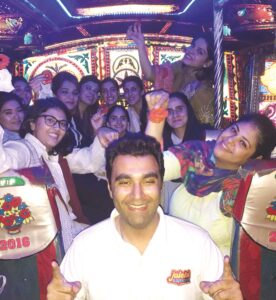
From its diverse cultures to its flavorsome cuisine, Karachi offers a vibrant tapestry of experiences. As Pakistan’s largest metropolis and its beating heart, Karachi seamlessly blends centuries of rich history with modernity. Join Moiz Saleem Ahmad of Jalebi Express, Karachi’s leading city-tour operator, as he takes us on an exciting journey to uncover the top places to visit in Karachi. In this city, every corner holds a story waiting to be told, and every sight ignites the imagination.

Flagstaff House:
Flagstaff House, also known as Quaid-e-Azam House, stands as a poignant tribute to the life and legacy of Muhammad Ali Jinnah, the revered founder of Pakistan. Designed by British architect, Moses Somake, this historic edifice served as Jinnah’s residence from 1944 until his passing in 1948, with his sister, Fatima Jinnah, residing there until 1964. The property was acquired by Jinnah in 1943 for the sum of one lac fifteen thousand rupees from its previous owner. Recognizing its significance, the Pakistani government took ownership of the building in 1985, preserving it as a museum, dedicated to commemorating the personal history of the nation’s most eminent figure.

Frere Hall:
Frere Hall, initially envisioned as Karachi’s town hall is a testament to the city’s rich architectural heritage, designed by Henry Saint Clair Wilkins. The acquisition of its land, costing 2,000 British Indian rupees, was made possible through donations from WP Andrew of the Scinde Railway and Sir Frederick Arthur Bartholomew. With a total expenditure of approximately 180,000 rupees, the Karachi municipality contributed significantly to its construction, supplemented by a government grant of 10,000 rupees.The construction of the hall commenced in August 1863, and concluded in October 1865, even though some elements remained unfinished at the time of its inauguration. Following Pakistan’s independence, the hall’s library was renamed Liaquat National Library, becoming one of Karachi’s largest repositories housing over 70,000 books, including rare manuscripts. Noteworthy is the hall’s embellishment by the esteemed Pakistani artist Sadequain in the 1980s. He adorned its ceilings with captivating murals, although one remained incomplete upon his demise in 1987. Other works by Sadequain adorn the hall, collectively forming the renowned “Gallery Sadequain.”
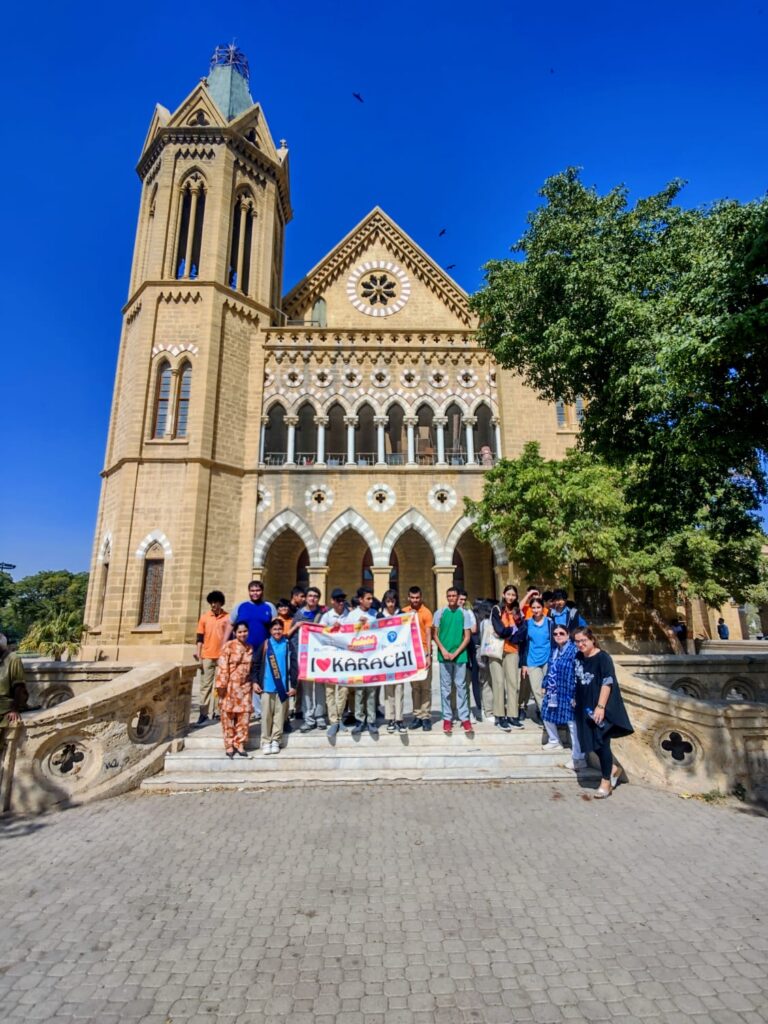


Freemasons Lodge:
The legacy of Freemasons Lodge Building in Karachi dates back to its construction in 1914 during the era of British rule. Situated on Molana Din Muhammad Wafai Road, the lodge was built by the Freemason’s Trust and served as a gathering place for the Freemason Society. However, due to linguistic and cultural barriers, locals unfamiliar with its purpose dubbed it “Jadoo Ghar,” meaning “the House of Magic.” Following the ban on Freemasonry in Pakistan in 1972 under the leadership of Zulfiqar Ali Bhutto, the government assumed control of the building. Subsequently, in the early 1990s, it was allocated to the Sindh Wildlife Department, currently utilized as office space for the Sindh Wildlife Department Conservator. Recognizing its historical significance, the site was designated a protected heritage site under the Sindh Cultural Heritage Act of 1994. Initiatives for renovation and preservation commenced in early 2009, with plans to repurpose a section of the building as a museum, ensuring the preservation of its cultural and architectural heritage for future generations.
Kabootar Chowk:
Kabootar Chowk, situated near the Sindh High Court, provides a serene escape from the hustle and bustle of the city. To find it, follow Burns Road until you reach the intersection, then turn right and stop at Kabootar Chowk. Here, vendors sell corn seeds, drawing visitors who delight in feeding pigeons. Once graced by Mahatma Gandhi’s statue, the square now offers a peaceful retreat for families and individuals alike. On Sundays, the area buzzes with people leisurely enjoying the simple pleasure of feeding the pigeons, a therapeutic ritual that fosters relaxation and a connection with nature.

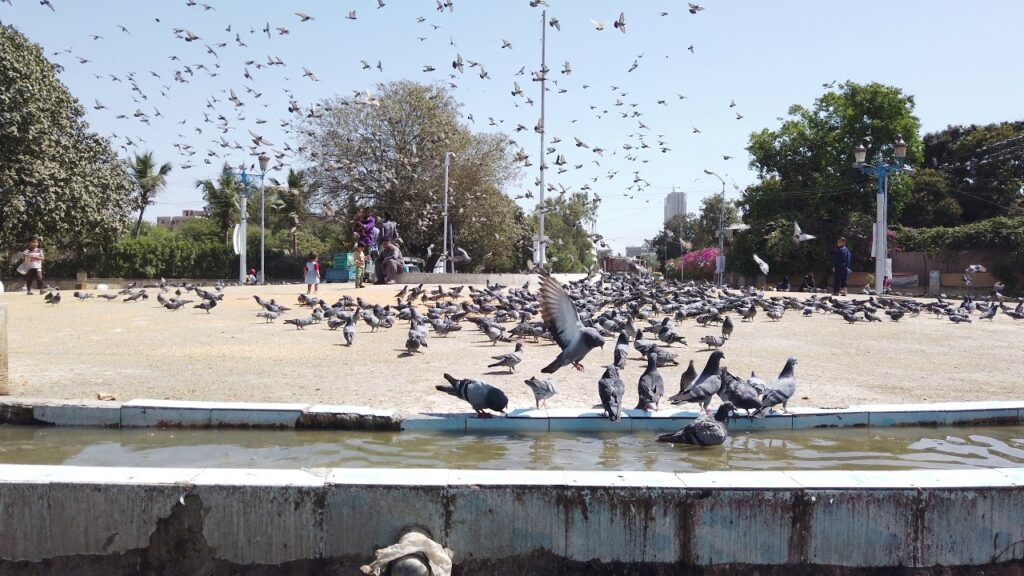
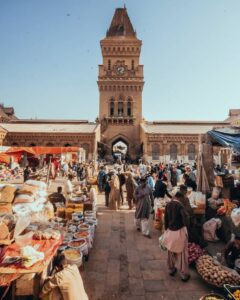
Empress Market:
The Empress Market in Karachi traces its origins back to the British Raj era, when it was initially constructed, evolving into one of the city’s premier shopping destinations. From essential groceries like condiments, fruits, vegetables, and meats, to a diverse array of goods such as stationery, textiles, and even pets, the market caters to a wide range of needs. Built between 1884 and 1889, it was named in honour of Queen Victoria, Empress of India, reflecting the colonial ties of the time.
Strategically located, the market’s site held historical significance as the location of brutal executions of native sepoys, whose heads were reportedly blown off by cannonballs to suppress potential uprisings. In a calculated move to prevent any memorialization of the executed sepoys by the local populace, the British decided to construct the Empress Market instead, ensuring a lasting tribute to Queen Victoria. The laying of the foundation stone in 1884 by James Fergusson, the then-Governor of Bombay, further underscores its historical importance, coinciding with the laying of the Merewether Memorial Tower.
Designed by architect James Strachan, the Empress Market stands as a testament to Karachi’s colonial past and remains a vibrant hub of commerce and culture in the present day.
Mazar-e-Quaid:
Mazar-e-Quaid, also known as the Jinnah Mausoleum or the National Mausoleum, serves as the final resting place of Quaid-e-Azam (“Great Leader”) Muhammad Ali Jinnah, the revered founder of Pakistan. Constructed in the modernist style of the 1960s, this esteemed site also houses the tombs of his sister, Māder-e-Millat (“Mother of the Nation”) Fatima Jinnah, and that of Liaquat Ali Khan, Pakistan’s first Prime Minister. Completed in 1970, the mausoleum stands as a symbol of Karachi’s identity.
Renowned architect Yahya Merchant designed the striking Mausoleum building, which is crafted from white marble adorned with graceful Moorish arches and copper grills. Within its serene confines, the interior exudes tranquility, illuminated by the verdant glow of a magnificent four-tiered crystal chandelier gifted by the People’s Republic of China.

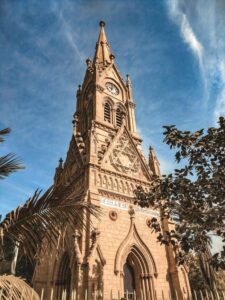
Merewether Tower:
The Merewether Tower, designed meticulously by James Strachan was built between 1884 and 1892 as a tribute to Sir William L. Merewether, who served as Commissioner of Sindh (1867-1877). This iconic structure features a larger bell at its summit, intended to chime the hour, accompanied by smaller bells signaling each quarter, adding a charming touch to the city’s soundscape.

The Eduljee Dinshaw Charitable Dispensary:
The Eduljee Dinshaw Charitable Dispensary holds significant historical importance as the first major building constructed in the Italianate architectural style. Inaugurated in 1882, it was designed by James Strachan, who served as the Municipality engineer during that period. This architectural masterpiece was commissioned by the esteemed philanthropist Eduljee Dinshaw, reflecting his commitment to serving the community through healthcare provisions.
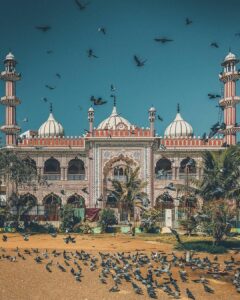
Aram Bagh (Ram Bagh):
Aram Bagh, formerly known as Ram Bagh, holds both historical and religious significance. According to Hindu belief, it is said that Hindu avatars Ram, Sita, and Lakshman rested at this site during their journey to the Hinglaj pilgrimage. In ancient Greek texts, Karachi itself was referred to as Ramya. Ram Bagh served as a venue for Hindu religious gatherings and festivities.
Following the partition of India, thousands of Muslim refugees established camps in Ram Bagh, leading to its renaming as Aram Bagh, meaning the garden of relaxation. Within Aram Bagh lies the Shiv Mandir, which welcomes visitors on Monday evenings. This temple was constructed by Astan Shrimati Hajeebai in honor of her husband, Ram Mangat Ram.
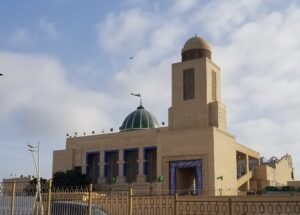
Abdullah Shah Ghazi’s Mazar:
Abdullah Shah Ghazi’s Mazar, situated on the sandy shores of the city for nearly ten centuries, stands as a testament to both spirituality and legend. Believers have long held the conviction that the shrine acts as a protective force, diverting cyclones away from Karachi.
The annual Urs of Hazrat Abdullah Shah Ghazi (20th to the 22nd of Dhu al-Hijjah) is a cherished occasion for Karachi’s residents. This celebration transcends religious boundaries, attracting even non-Muslims who admire the saint for his teachings of love, tolerance, and kindness.
Hindu Temple:
The Sri Lakshmi Narayan Mandir, affectionately known as the Hindu Temple, is a profound symbol of devotion and history. Constructed about two centuries ago, it holds the distinction of being the sole temple nestled along the serene banks of the China Creek. Dedicated to the worship of the revered goddess Lakshmi, it’s a spiritual sanctuary for countless devotees seeking solace and blessings. With its rich heritage and sacred significance, the Hindu Temple embodies the enduring cultural tapestry of the region, inviting visitors to immerse themselves in its timeless aura of reverence and tranquility.
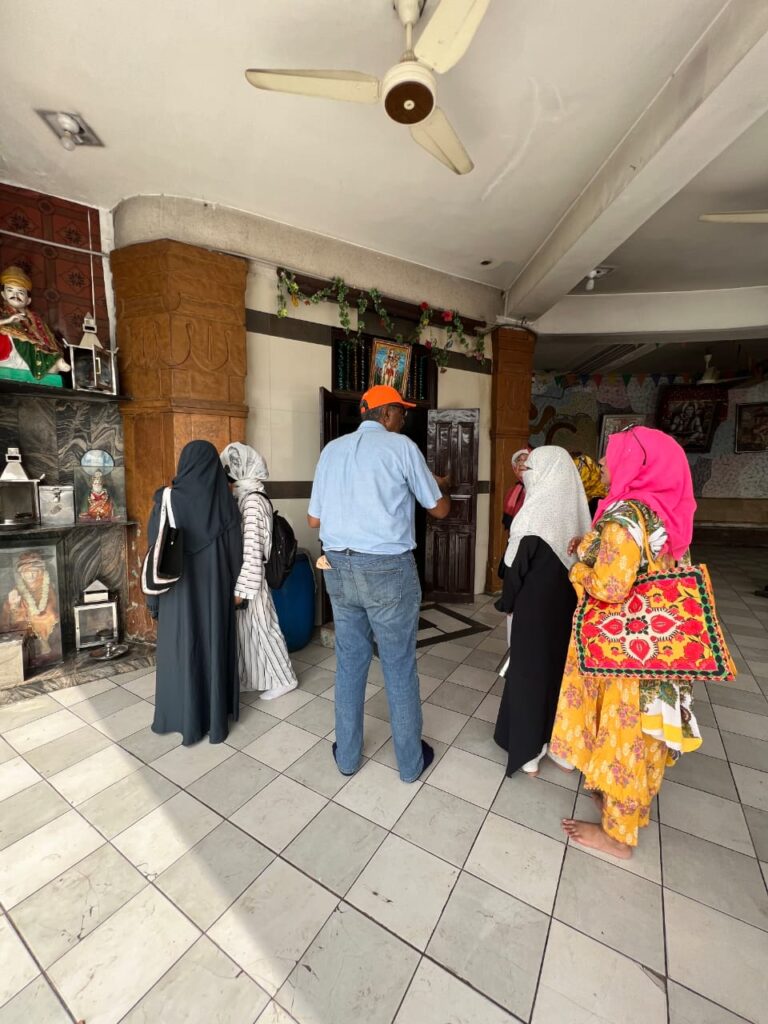
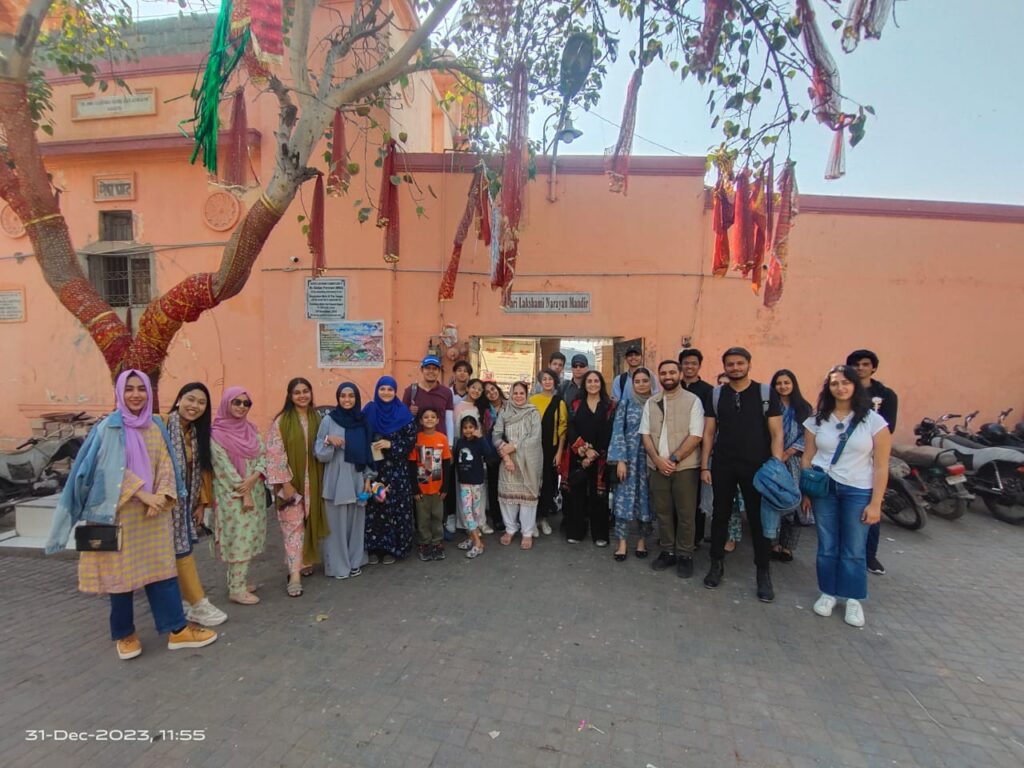
Port Grand:
Port Grand is renowned as one of the city’s largest entertainment hubs, boasting expansive food streets brimming with diverse culinary offerings. Moreover, it serves as a testament to the restoration of Karachi’s heritage sites, including the iconic Napier mole bridge. Through initiatives like Port Grand, Karachi’s rich cultural heritage is both preserved and celebrated, offering a vibrant hub where both locals and tourists can indulge in leisure activities and exploration alike.

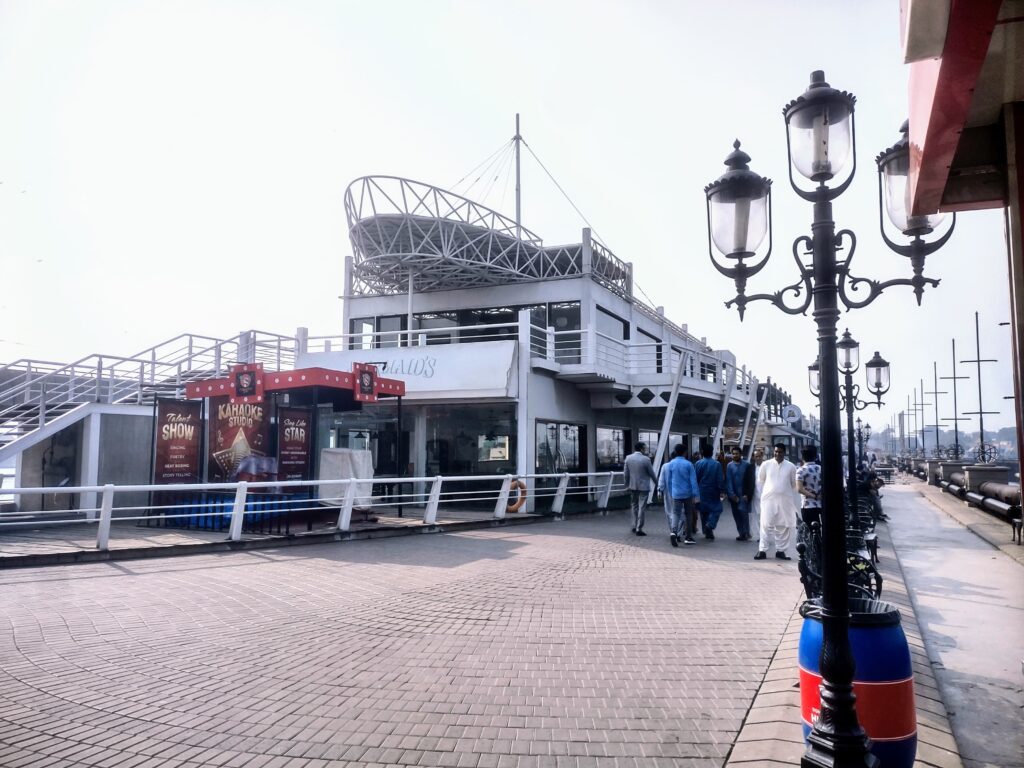
Karachi Port:
Karachi Port, inaugurated in 1854, is one of South Asia’s largest and most bustling deep-water sea ports. Handling a significant portion of the nation’s cargo, approximately 60%, this port plays a crucial role in Pakistan’s maritime trade. It is managed and overseen by the Karachi Port Trust, ensuring smooth operations and facilitating the movement of goods through its extensive facilities and infrastructure.

Café Bogie:
Café Bogie, situated within the historic City Railway Station in Karachi, utilizes refurbished train carriages to offer a unique dining experience. These carriages, nearly six decades old, once traversed the route between Karachi and the town of Mirpur Khaas in Sindh. As a testament to the region’s rich railway heritage, Café Bogie is more than just a restaurant; it pays homage to the past, being part of Sindh’s first-ever railway station.


Karachi is a treasure trove of experiences, offering a plethora of must-visit destinations to satisfy every traveler’s desires. So, pack your curiosity and embark on an adventure to explore the city, where you’re sure to create lifelong memories.
If you’re planning a trip to Karachi, be sure to include these spots in your itinerary. Or, for an even more immersive experience, hop on board Jalebi Express and join their signature tours aboard the famous W11 minibus.
Facts about Karachi:
• Karachi is the largest and most populous city in Pakistan.
• It is the capital of the province of Sindh.
• It spreads over an area of 1460 miles and is home to nearly 22 million people.
• It generates a GDP of $113 Billion and is the industrial and commercial hub of the country.
• It is a major port city on the Arabian Sea, making it a significant centre for trade and transportation, both domestically and internationally.
• It is known for its diverse population, with people from various ethnic, cultural, and religious backgrounds living together. Major ethnic groups include Muhajirs, Sindhis, Punjabis, Pashtuns, Baloch, and others.



